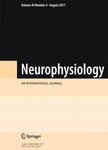版权所有:内蒙古大学图书馆 技术提供:维普资讯• 智图
内蒙古自治区呼和浩特市赛罕区大学西街235号 邮编: 010021

作者机构:Dnipropetrovsk Med Acad Minist Publ Hlth Ukraine Dnipro Ukraine Dnipropetrovsk Reg Council Rudnev Dnipropetrovsk Specialized Clin Med Ctr Mo Dnipro Ukraine Natl Acad Sci Ukraine Bogomolets Inst Physiol Kiev Ukraine
出 版 物:《NEUROPHYSIOLOGY》 (神经生理学)
年 卷 期:2017年第49卷第1期
页 面:8-18页
核心收录:
学科分类:0710[理学-生物学] 1001[医学-基础医学(可授医学、理学学位)] 07[理学] 071003[理学-生理学]
主 题:granule neuron (GN) dentate gyrus hippocampus TRP channels temperature sensitivity excitability epileptiform EEG therapeutic hypothermia computer models
摘 要:Synchronous burst discharges of action potentials (APs) of neurons are typical manifestations of cerebral epileptiform activity;such discharges are reflected in EEG as burst-suppression episodes. For elimination of drug-resistant epileptogenic foci, therapeutic hypothermia (controlled decrease in the body temperature) is increasingly used;at the same time, the mechanisms of its therapeutic effect remain largely unknown. We investigated one of the respective possible mechanisms on a model of the granule neuron (GN) of the hippocampal dentate gyrus. These cells are the first links in three-synaptic neuronal chains of the hippocampus;the latter is the brain region where sources of epileptiform activity are often localized. In the somatodendritic membrane of the GN model, thermosensitive channels of the TRP family, which conduct a depolarizing current, were included along with other ion channels inherent in these neurons. It has been found that such channels are indeed expressed in GNs. In response to tonic synaptic excitation uniformly distributed over the dendrites, the GN at 37 degrees C (normothermia) generated periodic multipulse burst discharges. Lowering the temperature to 36, 34, 32, and 30 degrees C (borders of weak, moderate, moderately deep, and deep therapeutic hypothermia, respectively) led to degradation of the bursting patterns and their transformation into low-frequency trains of separate APs. Precisely at these temperatures, is the depolarizing current through TRP channels deactivated. The phenomenon of degradation of bursting activity generated by the model GN corresponded to a multifold decrease in the amplitude, duration, and repetition frequency of the burst-suppression episodes in EEGs of newborn infants suffering from hypoxic-ischemic CNS injury, which we observed in clinics under conditions of moderate hypothermia (34 degrees C) used for treatment of such patients. These observations allow us to suggest that hypothermic suppression of bursting di